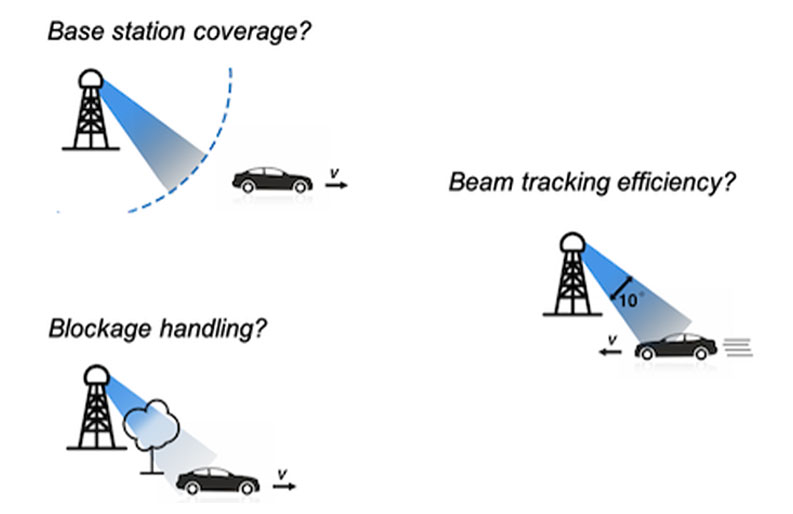Connected and Autonomous Vehicles
Site-Specific mmWave Channel Profiling, Prediction, and Network Adaptation
Usage of the mmWave frequencies is a key driver towards improving cellular network capacity for 5G and beyond. However, most of the current use cases are limited to static point-to-point settings, such as WirelessHD and Integrated Access and Backhaul. In contrast, anticipated 5G applications like immersive media and V2X will require mmWave to deliver LTE-like coverage, stability, and mobility support. The main challenge to meet this prospect lies in the fact that mmWave link performance becomes a sensitive function of the environment, due to strong attenuation, blockage, and reflection. We are exploring data driven approaches to tackle the challenges of mmWave in mobility scenarios.
At a high level, we leverage channel sensing data to profile and predict the spatial channel distribution in a site-specific manner. We then adapt the link and network parameters accordingly to optimize coverage and reduce beam management overhead. We adopt the V2X scenario as an example use case, but the approach can be generalized to other scenarios, such as indoor mmWave pico-cell networking.
Intelligent Network Planning through Channel Cartography
Significant optimizations can occur even before a mmWave network is deployed by performing accurate simulations of the expected environment. Typically, ray tracing simulations are used when determining coverage; however, newer methodologies are being proposed that utilize sparse measurements of the RF environment to produce even more precise results. Utilization of these simulations can allow evaluation of the network impact of various configurations that would otherwise be economically infeasible to measure, such as BS placement, antenna location on vehicles, codebook design, and phased array design. Ray tracing simulations have proven to be quite accurate for mmWave frequencies. They function by utilizing a 3D model of the environment that is annotated with material types of known wireless penetration/reflection properties. These 3D models are available for most urban areas. Combining this functionality with mobility data from a traffic simulator allows for modeling mmWave V2X scenarios.
While ray tracing can be quite accurate, it can’t be perfect. Material types can easily vary amongst locations, such as the density of walls or type of paint/coatings used. Other fine-grained properties of the environment aren’t accurately captured by 3D models such as foliage or the chamfers/bevels of buildings. Prior work has shown that the reflectors in a mmWave environment, and their properties, can be sensed directly from RF measurements. Clearly, incorporating these measurements into trace driven simulations can increase the accuracy of the observed simulation results and thus the conclusions drawn from them. We are examining how to incorporate sensing from other modalities, such as 3D vision, and how to leverage the knowledge gained from one geographic location to model a separate environment, in order to create more accurate RF environment models without high cost to operators during the planning stage.
Lifelong Learning at the Base Station
Accurate network planning can improve the efficiency of mmWave networks; however, environments inevitably change. In the long term, environments change due to seasons impacting the foliage in the environment or new construction. In the short term, networks are impacted by fluctuations in user movement/density and the introduction of dynamic, short lived, blockages. If a BS can continually learn from, and predict, its environment, it will be able to adapt to these changes and maintain or improve network capacity over time.
One example of this lifelong learning is Codebook Adaptation. Due to differences in RF propagation at higher frequencies, mmWave radios typically employ phased arrays to allow for increased directional gain that more than compensates for the increased path loss at higher frequencies. Since the radios need to quickly steer these beams to communicate with different users, these radios have a discrete set of beams it can use, termed a codebook, that determines the directional gains possible and it must choose amongst that set during operation. Obviously, the choice of this codebook can have a large impact on various physical layer metrics such as SNR, coverage, and beam coherence time. Further, there is unlikely to be a one-size-fits-all codebook since the terrains and user densities that each BS is deployed in differ from one another and can even vary throughout the day due to patterns of human movement (e.g. users flow into the city in the morning and out during the evening). Therefore, we are developing algorithms that are capable of adapting the codebook over the long term operation of a BS to improve operational metrics.
